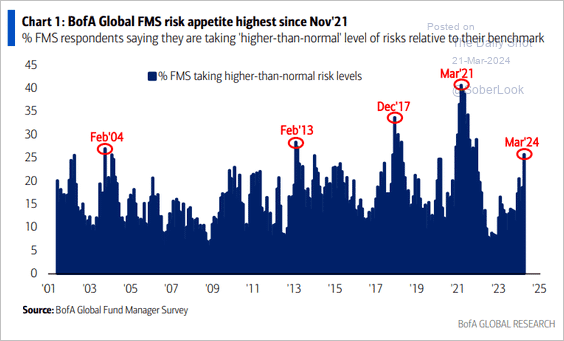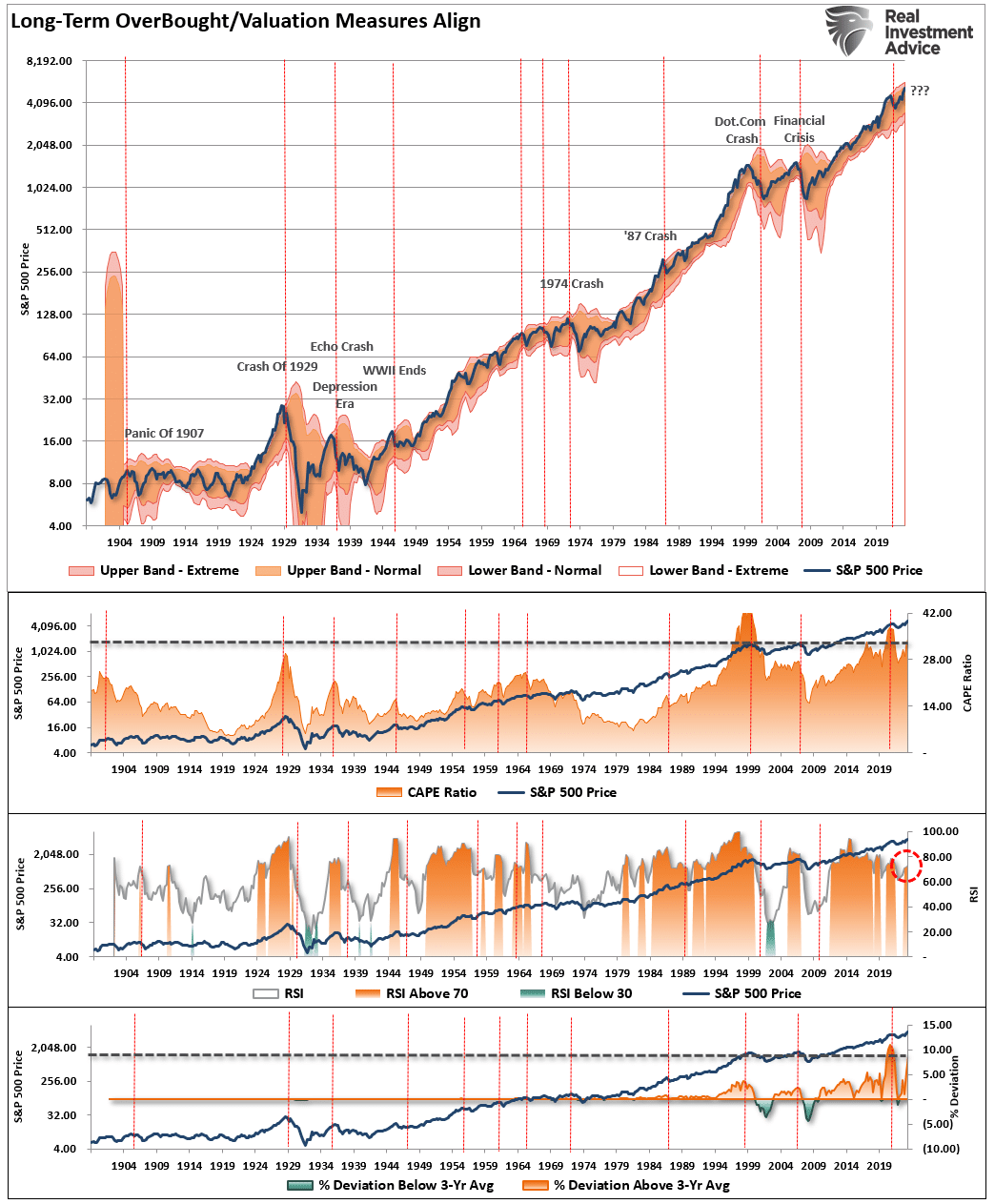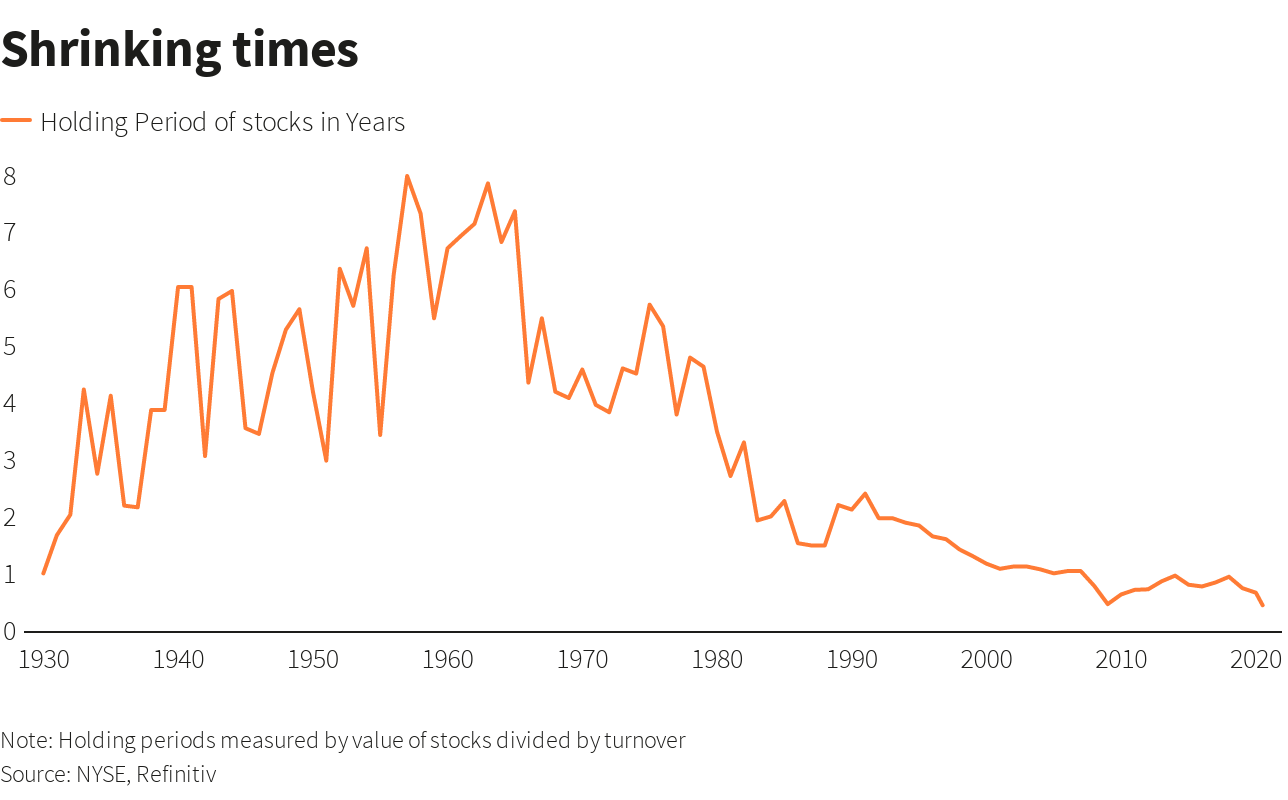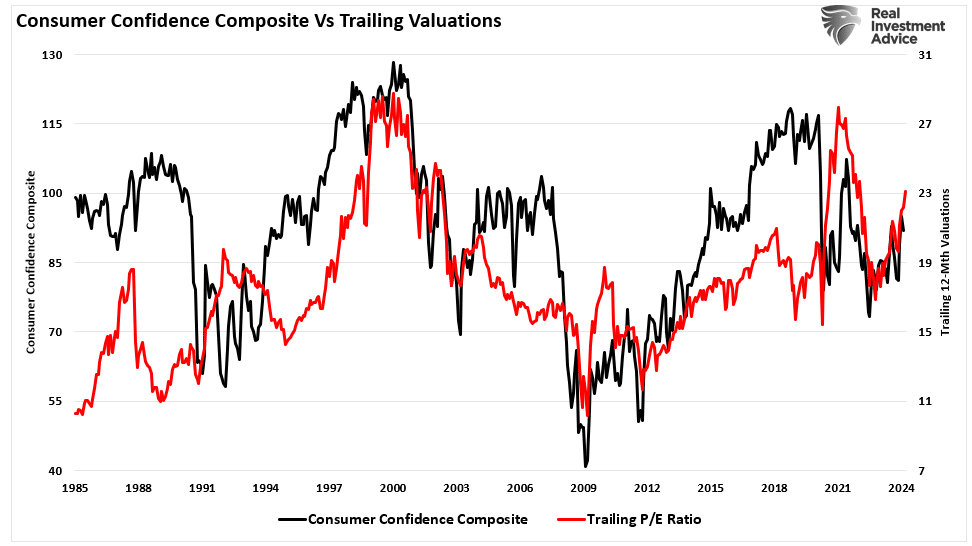Technical measures and valuations all suggest the market is expensive, overbought, and exuberant.
However, none of it seems to matter as investors pile into equities to chase risk assets higher. A recent BofA report shows that the increase in risk appetite has been the largest since March 2021.

Of course, as prices increase faster than underlying earnings growth, valuations also increase. However, as discussed in “Valuations Suggest Caution,” valuations are a better measure of psychology in the short term. To wit:
“Valuation metrics are just that – a measure of current valuation. More importantly, when valuation metrics are excessive, it is a better measure of ‘investor psychology’ and the manifestation of the ‘greater fool theory.’ As shown, there is a high correlation between our composite consumer confidence index and trailing 1-year S&P 500 valuations.”
When investors are exuberant and willing to overpay for future earnings growth, valuations increase. The increase in valuations, also known as “multiple expansion,” is a crucial support for bull markets.
As shown, the increase in multiples coincides with rising markets. Of course, the opposite, known as “multiple contractions,” is also true. With a current Shiller CAPE valuation multiple of 34x earnings, such suggests that investor confidence is elevated.
As noted, valuations are terrible market timing indicators and should not be used for such. While valuations provide the basis for calculating future returns, technical measures are more critical for managing near-term portfolio risk.
Technical Measures Are Getting Extreme
As noted, investors are again becoming exuberant over stock ownership. Such is vital to creating multiple expansions and fueling bull market advances. High valuations, bullish sentiment, and leverage are meaningless if the underlying equities are not owned.
As discussed in “Household Equity Allocations,” the current levels of household equity ownership have reverted to near-record levels. Historically, such exuberance has been the mark of more important market cycle peaks.

While household equity ownership is critical to expanding the bull market, the technical measures provide an understanding of when excesses are reached. One measure we focus on is the deviation of price from long-term means.
The reason is that markets are bound to long-term means over time. For a “mean” or “average” to exist, prices must trade above and below that price over time.
Therefore, we can determine when deviations are approaching more extreme levels by viewing past deviations. Currently, the deviation of the market from its underlying 2-year average is one of the largest in history.
Notably, there have certainly been more significant deviations in the past, suggesting the current deviation from the mean can grow further. However, such deviations have crucially been a precursor to an eventual mean-reverting event. 
The following analysis uses quarter data and evaluates the market using valuation and technical measures. From a long-term perspective, the market is trading at more extreme levels.
The quarterly Relative Strength (RSI) measure is above 70, the deviation is close to a historical record, and the market trades nearly 3 standard deviations above its quarterly mean.
As noted, while these valuation and technical measures can undoubtedly become more extreme, the ingredients for an eventual mean reverting event are present.

Of course, the inherent problem with long-term analysis is that while valuations and long-term technical measures are more extreme, they can remain that way for much longer than logic suggests. However, we can construct a valuation and technical measures model using the data above.
As shown, the model triggered a “risk off” warning in early 2022 when high valuations collided with an extreme deviation of the market above the 24-month moving average.
That signal was reversed in January 2023, as the market began to recover. While a new signal has not yet been triggered, the ingredients of valuations and deviations are present. 
The Ingredients Are Missing A Catalyst
The problem with long-term technical measures and valuations is that they move slowly. Therefore, the general assumption is that if high valuations do not lead to an immediate market correction, the measure is flawed.
In the short term, “valuations” have little relevance to what positions you should buy or sell. It is only momentum, the direction of the price, that matters. Managing money, either “professionally” or “individually,” is a complicated process over the long term.
It seems exceedingly easy in the short term, particularly amid a speculative mania. However, as with every bull market, a strongly advancing market forgives investors’ many investing mistakes. The ensuing bear market reveals them in the most brutal and unforgiving of outcomes.
There is a clear advantage to providing risk management to portfolios over time. The problem is that most individuals cannot manage their own money because of “short-termism.” As shown by shrinking holding periods.
While “short-termism” currently dominates the investor mindset, the ingredients for a reversion exist. However, that does not mean one will happen tomorrow, next month, or even this year.
Think about it this way. If I gave you a bunch of ingredients such as nitrogen, glycerol, sand, and shell, you would probably stick them in the garbage and think nothing of it.
They are innocuous ingredients and pose little real danger by themselves. However, you make dynamite using a process to combine and bind them. However, even dynamite is safe as long as it is stored properly. Only when dynamite comes into contact with the appropriate catalyst does it become a problem.
“Mean reverting events,” bear markets, and financial crises result from a combined set of ingredients to which a catalyst ignites. Looking back through history, we find similar elements every time.
Like dynamite, the individual ingredients are relatively harmless but dangerous when combined.
Leverage + Valuations + Psychology + Ownership + Momentum = “Mean Reverting Event”
Importantly, this particular formula remains supportive of higher asset prices in the short term. Of course, the more prices rise, the more optimistic investors become.
While the combination of ingredients is dangerous, they remain “inert” until exposed to the right catalyst.
What causes the next “liquidation cycle” is currently unknown. It is always an unexpected, exogenous event that triggers a “rush for the exits.”
Many believe that “bear markets” are now a relic of the past, given the massive support provided by Central Banks. Maybe that is the case. However, remembering that such beliefs were always present before more severe mean-reverting events is worth remembering.
To quote Irving Fisher in 1929, “Stocks are at a permanently high plateau.”

